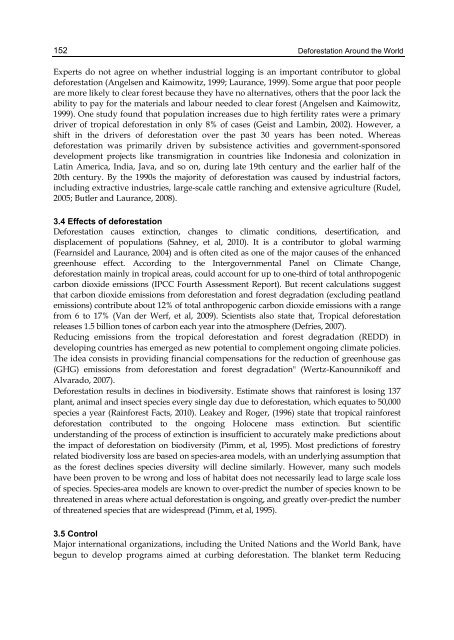DEFORESTATION AROUND THE WORLD - India Environment Portal
DEFORESTATION AROUND THE WORLD - India Environment Portal
DEFORESTATION AROUND THE WORLD - India Environment Portal
Create successful ePaper yourself
Turn your PDF publications into a flip-book with our unique Google optimized e-Paper software.
152<br />
Deforestation Around the World<br />
Experts do not agree on whether industrial logging is an important contributor to global<br />
deforestation (Angelsen and Kaimowitz, 1999; Laurance, 1999). Some argue that poor people<br />
are more likely to clear forest because they have no alternatives, others that the poor lack the<br />
ability to pay for the materials and labour needed to clear forest (Angelsen and Kaimowitz,<br />
1999). One study found that population increases due to high fertility rates were a primary<br />
driver of tropical deforestation in only 8% of cases (Geist and Lambin, 2002). However, a<br />
shift in the drivers of deforestation over the past 30 years has been noted. Whereas<br />
deforestation was primarily driven by subsistence activities and government-sponsored<br />
development projects like transmigration in countries like Indonesia and colonization in<br />
Latin America, <strong>India</strong>, Java, and so on, during late 19th century and the earlier half of the<br />
20th century. By the 1990s the majority of deforestation was caused by industrial factors,<br />
including extractive industries, large-scale cattle ranching and extensive agriculture (Rudel,<br />
2005; Butler and Laurance, 2008).<br />
3.4 Effects of deforestation<br />
Deforestation causes extinction, changes to climatic conditions, desertification, and<br />
displacement of populations (Sahney, et al, 2010). It is a contributor to global warming<br />
(Fearnsidel and Laurance, 2004) and is often cited as one of the major causes of the enhanced<br />
greenhouse effect. According to the Intergovernmental Panel on Climate Change,<br />
deforestation mainly in tropical areas, could account for up to one-third of total anthropogenic<br />
carbon dioxide emissions (IPCC Fourth Assessment Report). But recent calculations suggest<br />
that carbon dioxide emissions from deforestation and forest degradation (excluding peatland<br />
emissions) contribute about 12% of total anthropogenic carbon dioxide emissions with a range<br />
from 6 to 17% (Van der Werf, et al, 2009). Scientists also state that, Tropical deforestation<br />
releases 1.5 billion tones of carbon each year into the atmosphere (Defries, 2007).<br />
Reducing emissions from the tropical deforestation and forest degradation (REDD) in<br />
developing countries has emerged as new potential to complement ongoing climate policies.<br />
The idea consists in providing financial compensations for the reduction of greenhouse gas<br />
(GHG) emissions from deforestation and forest degradation" (Wertz-Kanounnikoff and<br />
Alvarado, 2007).<br />
Deforestation results in declines in biodiversity. Estimate shows that rainforest is losing 137<br />
plant, animal and insect species every single day due to deforestation, which equates to 50,000<br />
species a year (Rainforest Facts, 2010). Leakey and Roger, (1996) state that tropical rainforest<br />
deforestation contributed to the ongoing Holocene mass extinction. But scientific<br />
understanding of the process of extinction is insufficient to accurately make predictions about<br />
the impact of deforestation on biodiversity (Pimm, et al, 1995). Most predictions of forestry<br />
related biodiversity loss are based on species-area models, with an underlying assumption that<br />
as the forest declines species diversity will decline similarly. However, many such models<br />
have been proven to be wrong and loss of habitat does not necessarily lead to large scale loss<br />
of species. Species-area models are known to over-predict the number of species known to be<br />
threatened in areas where actual deforestation is ongoing, and greatly over-predict the number<br />
of threatened species that are widespread (Pimm, et al, 1995).<br />
3.5 Control<br />
Major international organizations, including the United Nations and the World Bank, have<br />
begun to develop programs aimed at curbing deforestation. The blanket term Reducing

















